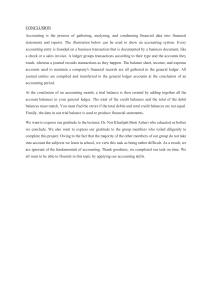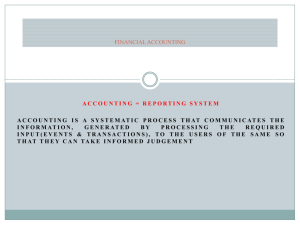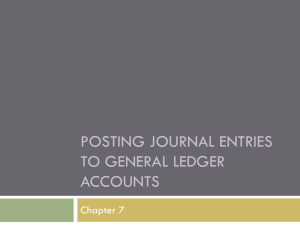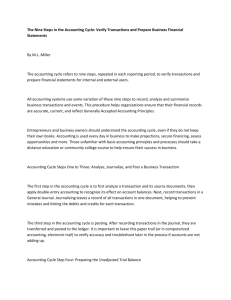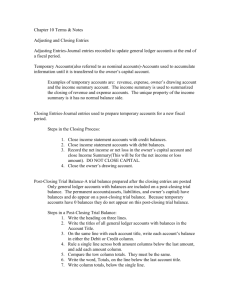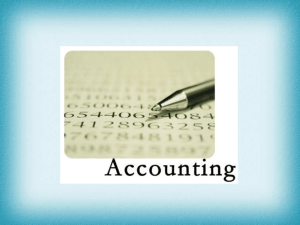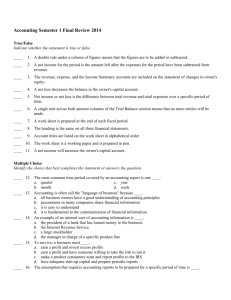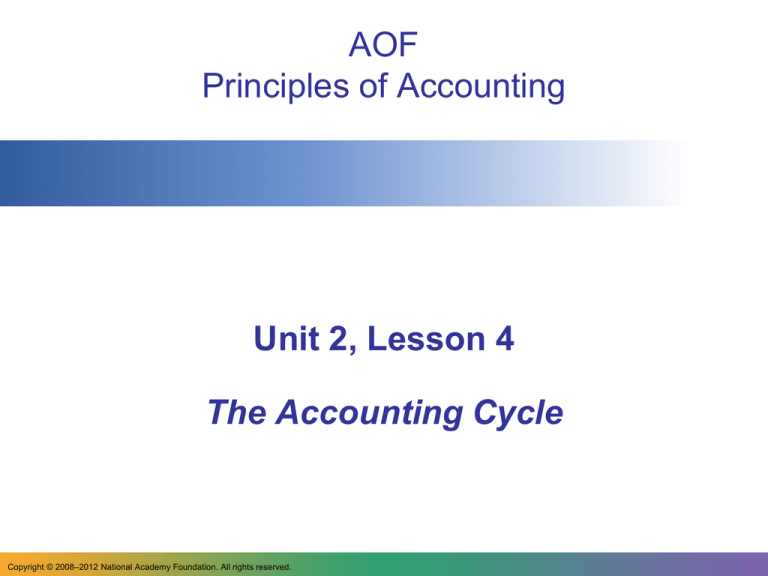
AOF
Principles of Accounting
Unit 2, Lesson 4
The Accounting Cycle
Copyright © 2008–2012 National Academy Foundation. All rights reserved.
Accounting is important in today’s world
• Accounting is an integral part of
running a business.
• Accounting expertise helps
businesspeople make decisions,
no matter what their job is.
• Accounting is important to a
person’s financial literacy.
How can accounting knowledge benefit you?
The accounting cycle is a series of steps
1. Collect and analyze source documents
2. Journalize each transaction chronologically
3. Post to the general ledger
4. Prepare a trial balance
5. Prepare financial statements
6. Perform post-closing journal entries (bring temporary
account balances to $0)
7. Perform post-closing trial balance (to make sure the
general ledger is in balance after closing entries)
The first step of the accounting cycle: collect and analyze
source documents
• Source documents are the
evidence that a business
transaction occurred.
• Cash receipts, cancelled
checks, purchase orders,
and deposit slips are all
examples of source
documents.
What other examples
of source documents
can you think of?
The second step of the accounting cycle: journalize each
transaction chronologically
• A general journal contains
a chronological listing of a
business’s financial
transactions.
• Journalizing is the process
of recording financial
transactions into a
journal.
• Before entering a
transaction into the
journal, you must decide
which accounts will be
affected.
Why would you want to
organize financial
transactions in the order
in which they occurred?
The third step of the accounting cycle: post to the general
ledger
• A general ledger keeps specific
account information together
and tracks individual account
balances.
• The information from the
journal is transferred to the
respective account in the
general ledger in chronological
order.
Why would it be helpful
to track the financial
information from specific
accounts?
The fourth step of the accounting cycle: prepare a trial
balance
• A trial balance lists account
names and their balances on a
specific date.
• It proves the general ledger is in
balance.
• You can detect errors by
preparing a trial balance.
• The sum of all debits must equal
sum of all credits.
What are some types of errors that can be made
during the accounting cycle?
The final steps to the accounting cycle: prepare financial
statements and close the books
• Businesses report information in the form of financial
statements. There are four main types of financial
statements: the balance sheet, income statement,
statement of owner’s equity, and statement of cash
flow.
• Each financial statement reports specific financial data
to show decision makers how the business has
performed.
• The accounting cycle ends with temporary account
balances (revenue, expenses, and withdrawals) being
transferred to the owner’s capital account. Those
accounts then start the next cycle with zero balances
and accumulate financial data for the next cycle.

